First Russian Fleet - Pirates of the Terrible Tsar
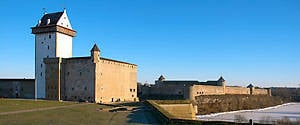 Leafing through the pages of the annals of the Russian fleet, we recall the campaigns of Russian princes under the walls of Constantinople, the exploits of ushkuyniki, the raids of the Cossacks in the Black and Caspian Seas, and, of course, the construction of the fleet by Peter the Great.
Leafing through the pages of the annals of the Russian fleet, we recall the campaigns of Russian princes under the walls of Constantinople, the exploits of ushkuyniki, the raids of the Cossacks in the Black and Caspian Seas, and, of course, the construction of the fleet by Peter the Great.But few people know that in school programs there is no Russian about this stratum. stories not a line about the pirate fleet of Ivan Vasilyevich.
Foreign policy problems of Ivan IV
The young king inherited a bunch of problems, both domestic and foreign. On the southeastern border, fragments of the Horde — the Crimean, Astrakhan, Kazan, and Siberian Khanates — sat in thrusts. From the north-west hung Sweden, Poland.
Having brilliantly solved the problems of the Kazan and Astrakhan khanates, Ivan IV faced the problem of choosing where to strike the main blow, to which sea to break through - to the Black or Baltic Sea.
The Tsar's entourage, the “Chosen Rada,” opposed a strike on the Livonian Order, they believed that the main blow should be inflicted on the Crimean Khanate, which hampered the development of the Moscow kingdom and closed the exit to the Black Sea and the fertile lands of the south.
Help: Chosen Rada - the term introduced by Prince A. M. Kurbsky to designate the circle of persons who constituted the informal government under Ivan the Terrible in 1549 — 1560. It consisted of: the clergyman of Tsar Sylvester, the nobleman A. F. Adashev, the metropolitan Makary, the princes Kurbsky and Kurlyatev, and others.
Ivan Vasilyevich decided to deliver the next blow to Livonia - the order was "decrepit", militarily weak, and there was the appearance that Russia would easily make its way to the Baltic Sea. Although at that time Moscow had access to the Baltic - the coast of the Gulf of Finland between Ivangorod and Vyborg, the mouths of the Narova, Neva, Luga rivers. But the temptation to take the cities, the ports of Livonia, to expand its presence in the Baltic was strong. In addition, it could be justified by the fact that, they say, “we return ours”: for example, Dorpat-Yuryev was founded by Yaroslav the Wise, and the local tribes paid tribute to Russia and were under her hand.
The benefit of striking Livonia was still in military terms - Moscow could put 100-thousandth fully combat-ready army, the Livonian Order lost its combat capability long ago, it could assemble no more than 10 thousand soldiers, its main force was powerful fortresses. His strongest detachments were detachments of mercenaries, but they were very few in number, while the local people - Livs, Estonians, Letts - hated their masters and lived in the position of movable property, so they would not have resisted. It was dangerous to fight the Krymchaks, with tens of thousands of mobile cavalry troops, behind whose back the powerful Ottoman Empire.
Milestones of the Livonian War
At the end of 1558, the Russian army entered Livonia and by the summer almost without resistance occupied most of its territory. In 1560, the Livonian Order was finally crushed.
But other claimants were found on such a “tasty piece” - the Lithuanians were the first to get involved in the war. The Grand Duchy of Lithuania seized Riga and Courland, and Vilnius governor Nikolai Radzivil declared Livonia to be part of Lithuania. In 1561, the Polish-Lithuanian army occupied one of the Revel fortresses not captured by the Russian army. Then Sweden intervened, the Swedish landing with a sudden blow knocked the Polish-Lithuanian forces out of Revel.
Moscow faced the threat of war with two mighty European powers. The Moscow "Blitzkrieg" turned into an endless, exhausting war with two first-class armies and another with the Crimean horde on a huge front from the Neva to the Izyum route.
The Commonwealth offered peace for a part of the territory of Livonia, but Ivan Vasilyevich was adamant, in response, he demanded that the lands of Polotsk and Kiev principalities be returned to Russia.
Maritime Theater Problem
If it was convenient to fight with the Polish-Lithuanian Commonwealth - almost the entire western border, from Chernigov to Vilna, the war with Sweden was problematic. For example, in 1568, the Russian army was unable to take Revel precisely because the Swedish fleet supplied the fortress garrison with sea with everything necessary, from food and ammunition to the delivery of fresh troops. In addition, the Swedish fleet launched a hunt for merchant ships that came to us.
Poland, which did not have a fleet, turned the vassal Danzig and the Livonian Pernau-Pärnu into its naval bases, the "Narva navigation" was almost destroyed.
Ivan Vasilyevich wanted to “answer”, he needed a fleet. In Russia in Pomorie and Novgorodchina there were people familiar with the sea, from which teams could be recruited, there were carpenters who could build ships. But there were no navigators, naval military experts.
And the king came up with a brilliant plan - to the threat of Swedish and Polish piracy, we will answer the same - we hire privateers.
Danish help
Who read and remembers the Northern War, which Peter the Great led with Sweden, knows that Denmark, a longtime rival of Sweden, was our ally in the struggle for primacy in Northern Europe.
Denmark and under Ivan Vasilievich helped us, in their own interests, of course, and not from humane motives. Sweden was a part of the Danish possession and left its structure only in the 20-s of the 16 century, Copenhagen was not averse to punishing the Swedes. As soon as the king gave orders to the merchants and officials of the Ambassadorial order to find the right person, the monarch of Denmark, Frederick II, himself found and personally recommended.
It was already known in the Baltic captain Carsten Rode. A rather mysterious person — there is no information either about his date of birth, or about the date of death, or reliable information about his life journey to the service of the Russian tsar. There is only fragmentary information that he could fight in the Mediterranean under the command of Admiral Doria, was “the royal corsair in the service of the king of Denmark, fought against the Swedes. Rode was in the service of the brother of the Danish king, Duke Magnus. And the Duke Magnus was the ruler of Courland and Ezel, considered a loyal ally of Ivan the Terrible, because he wanted to get the title of King of Livonia from the hands of the Russian tsar.
Carsten Rode was not a noble family, he was a strong and tall man. He was distinguished by great faith and could execute any person, "so as not to incur God's wrath on the ship." Which, apparently, was also terrible to the king's liking.
The Russian tsar assigned Rode the title of "a punished captain" and "a sea otaman", and also issued a patent certificate - the letter of marque. Rode became a real royal governor at sea and received a royal decree: "..." With the power of enemies to take, and their ships with fire and sword to find, hook and destroy. And our voivods and clerks of men tovovo otman of Karsten Rode and his skipers, comrades and helpers, to our shelters on the sea and on land in saving and honor, stock, or what they need, how to bargain, raise, not to offend. ” The letter also contained a strict statement: “... by not attacking anyone and not repairing anybody’s losses,” but this reservation was aimed at removing responsibility for the actions of the privateer from the employer and was common in such cases.
Rode, in turn, vowed to deliver the best cannons from captured ships, the tithe of loot, and every third ship to Narva.
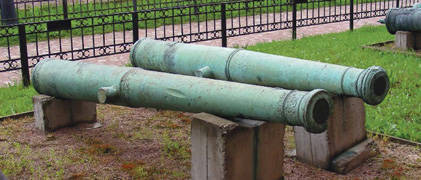
The first admiral of the Russian fleet
In fact, Carsten Rode is the first admiral of the Russian fleet, although he still had to create this fleet. In the early summer of 1570, Rode arrived at Ezel, where he bought a ship for the tsarist gold, where he received another letter of marque from Duke Magnus. The ship was named the "Merry Bride", the 1-th ship of the Russian fleet of the Terrible Tsar. It was a pink, three-masted cargo ship with a tonnage of 40 tons. Rode was recruited by a team man 35, armed the ship with three cast iron cannons, 10 with smaller tools (leopards), 8 with food and “two pickaxes for breaking the boards”.
Help: Pink (born pink) - fishing and merchant vessel of the 15th-19th centuries with a flat bottom, bulging sides and narrow stern; 2 was in northern Europe, and 3 masts with oblique sails on the Mediterranean. In the Mediterranean, the kicks (from the Italian "pinco") were merchant ships. They looked like shebeks, differing from them in greater height and a flatter bottom. On the Baltic Sea and in the Atlantic Ocean, any small vessel with a narrow stern was called a kick (from the Dutch “pincke”). In the 17th and 18th centuries, large kicks with straight sails were used as merchant and military ships. Many captains appreciated their speed and maneuverability.
But the sea god loves the desperate: just a few days after going out to sea, Rode attacked the first target - the Swedish military flutes. Interestingly, Rode went under the ancient Russian combat banner - “scarlet thread”, the flag of red. The Swedish ship is better armed and more, but tried to dodge the battle and escape. The "great bride" with great difficulty caught up with the Swedes, after an artillery duel the ship of the Swedes was taken aboard.
The booty was brought to the island of Bornholm, which Denmark rented out to the Hansa. This island was a privateer, a kind of naval base. A Danish squadron was also standing there, and the Danish admiral, considering the fleet of Ivan the Terrible to be an ally, helped by locations and maps. Rode joined the team, including those sent from Russia and the Danes. Bornholm will become one of the bases of the Russian fleet.
Within two weeks, Rode captured several more Swedish and Polish merchant ships. Then his flotilla moved south to Danzig. In the middle of summer, the Rode flotilla from 3's ships attacked a caravan of 5-ti ships that came with a load of rye from Danzig-Gdansk. The merchant caravan resisted, but Rode scrambled up, only one ship was able to escape. A little later, he defeated a caravan of 17-ti ships, marching from Danzig, not a single ship left.
The 1 ship for the Russian fleet arrived in Narva. Narva and Ivangorod were supposed to become the main bases of Rode, but the proximity of Sweden and the war that went on put them in jeopardy, so Rode was based on Bornholm, then Revel, then on the Moonsund Islands, then relocated to Denmark.
Carsten Rode acted very successfully and brazenly, the Russian sailors under his command quickly mastered, showed courage and discipline.
Great help was provided by Denmark: for example, 31 in July, 1570, in Gdansk, learned about the loss of the caravan and decided to send a punitive expedition. The Polish squadron reached Bornholm, it was met by the fleet of Denmark. Finding out what was wrong, the Danish admiral said that Rode’s ships had departed in the direction of Copenhagen (although they were in Bornholm). I offered to rally them, so that there were no misunderstandings, before the Swedish capital, the Poles agreed. At the harbor of Copenhagen, the Danish fleet opened fire and forced the Polish ships to enter the harbor. There they were captured, and the Poles were informed that once the Poles were allies of Sweden, and we are at war with the Swedes, we will confiscate the ships. The Danish king did not react to the complaints of the Swedish, Polish, and his merchants.
The Swedes staged a real “hunt” for the Russian squadron, even once the Swedish fleet overtook its squadron. Several ships died, but the rest broke through to Copenhagen and disappeared under the protection of the batteries of the Danish king.
By September, 1570, under the command of Rode, were 6 ships with quite combat-ready crews. Rode under the auspices of two monarchs created in fact a "pirate state". He captured more than 20 ships with a total value of half a million silver hoaximstalers in less than a year. The Poles thought of even complaining about the Kind to Ivan the Terrible (!) For the "dishonest" methods of war.
Moreover, Sweden and Poland were annoyed not only by the “excesses” of Rode, but also by the fact that Moscow had a fleet headed by a real professional in their field, who was the “admiral of the tsar” and whose sailors received a royal salary. The Russian fleet was constantly growing, already counting 17 pennants.
The end of the "sea chieftain"
The last sea battle squadron Rode took the fall 1571 year, the Swedes set a trap - for the merchant ship, "bait" were three frigates. When Rode attacked the "bait", the frigates attacked. The squadron Rode suffered losses, but recovered, and the Swedes were defeated, the Russian gunners crushed their artillery, and then the Swedish ships took to the boarding.
But here the Danish king, justifying himself by the fact that Rode began to seize merchants in the waters of Denmark, disrupting her trade, and under the pressure of her neighbors, ordered her to be placed under house arrest. The teams were disbanded, ships and property confiscated.
Rode was under house arrest for several years, and then disappeared. Ivan the Terrible demanded that he be returned to Russia, since this was his admiral, and he himself could hold a trial over him, but the Danish king refused.
About Carsten Rode - the first Russian admiral - no more information. Maybe he ran, maybe he bought off, or he was killed, so that “the ends in the water” (connection with the Danish monarch).
Ivan the Terrible was thinking about the creation of the second Baltic squadron, but the war was finally unsuccessful. Sweden, taking advantage of the fact that the main forces of the Russian army fought off the invasion of Stefan Batory, with a blow from Finland seized the entire Russian coast with Ivangorod. The Livonian War ended in heavy defeat. Muscovy, waging war on three fronts - southern (Crimean Khanate), western (Rzeczpospolita), northern (Sweden) - was defeated.
But we must remember that it was by the will of Ivan the Terrible that the Russian fleet in the Baltic was created, under the command of the talented Carsten Rohde, who successfully acted on the Baltic theater of operations. And if the war was different, the creation of the Russian fleet and the “cutting through the window” to the west would be associated with the name of Ivan Vasilyevich, and not Peter the First.
Modern Denmark and Bornholm
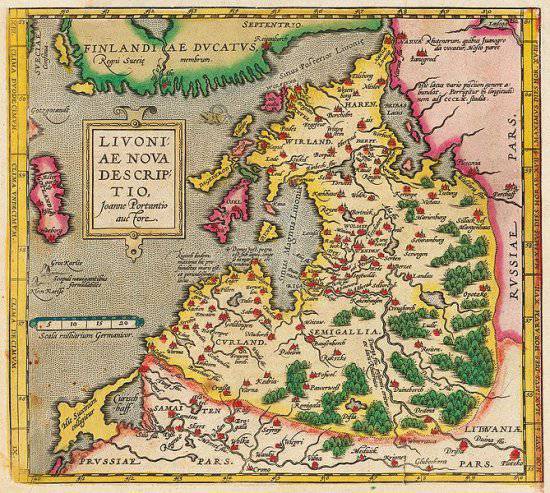
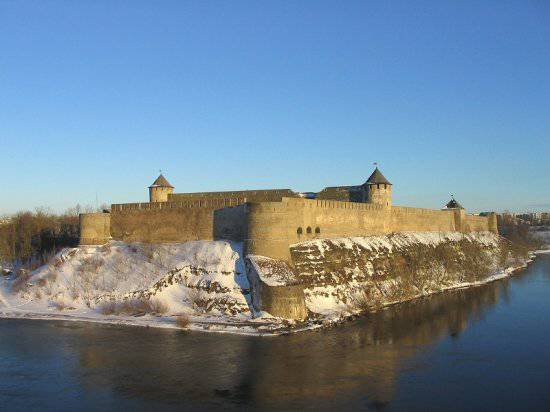
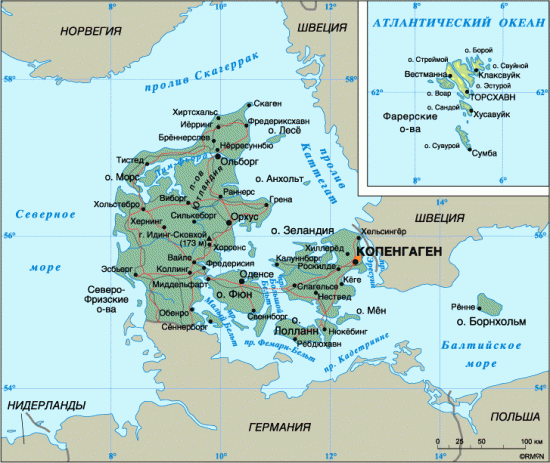
Information